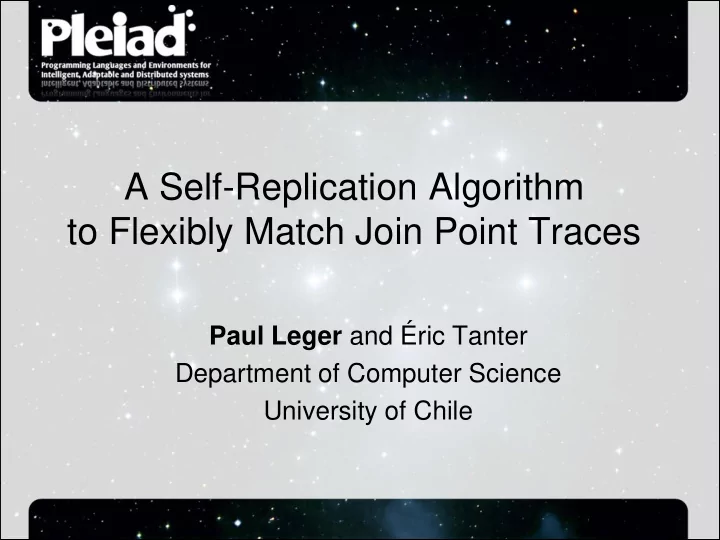

A Self-Replication Algorithm to Flexibly Match Join Point Traces Paul Leger and Éric Tanter Department of Computer Science University of Chile
Stateful Aspects In a Nutshell An aspect can only match a single join point A stateful aspect can match a join point trace [Douence+2005] c d a b Stateful aspects are used in security flaws, application errors, and crosscutting concerns 2
Algorithms to Match Join Point Traces a b V Sequence Join Point a a b 1 1 Trace The matches of a sequence depend on Multiple Matches with v=1 Or this Single Match Multiple Matches Single Match the matching semantics of the algorithm 3
Fixed Semantics to Match Traces Autosave feature : the document is automatically saved every three editions Tracematches tracematch() { support sym edit after: call(Editor.edit()); multiple matches sym save after: call(Editor.save()); edit edit edit { An artificial symbol is added to support Editor.save(); single match } } edit → edit → edit → save → edit → edit → edit → save edit → edit → edit → edit → edit → edit To adapt the matching semantics of an algorithm, developers code around it 4
Matcher Cells An algorithm to flexibly match join point traces, where developers can define their own semantics Based on self-replication behavior
Self-Replicating Behavior In a Nutshell Reactions of biological cells into a solution to a reagent trace reagent creation Cell nothing death solution 6
Matcher Cells A cell contains a sequence and bound variables, and a reagent corresponds to a join point v a b b v a 1 a b v a b b v=1 b v=1 v=1 v Seed a b C 0 = { } Match R = { … } cell 7
Examples of Matching Semantics with Matcher Cells With simple reaction rules, Matcher Cells makes it possible to express a wide range of matching semantics
Multiple Matches b b b a a a b a b a b b C 0 = { } a b b R = { apply reaction } a b b 9
Single Match b a a a b b b C 0 = { } a b R = { apply reaction, kill creators } 10
Single Match at a Time (the autosave feature solution) b a a a b b b C 0 = { } a b R = { apply reaction, kill creators, a b add seed } 11
Life-time for a Match Δ t > time a a b a b b … C 0 = { } a b R = { apply reaction, kill creators, trace life-time, add seed } 12
Only the First Match b v=1 b a 1 v=1 a 2 v=z v=z v z a b v z v=z a b v z a b v=z v=z a 2 b v=2 v=z b 2 b 2 C 0 = { } v z a b v=2, z =2 v=z R = { apply reaction, kill all cells after match } 13
An implementation of Matcher Cells Matching semantics is defined by the composition of rules (small functions)
Reaction of a Cell react: Cell x JP → Cell • returns a new cell if matches • returns the same cell if does not match the join point 15
Rules rule: List<Cell> x JP → List<Cell> var applyReaction = function (cells, jp) { The elemental rule return removeDuplicates(append(cells, map(cells, react, jp))); } var killCreators = function (rule) { Rule designators return function (cells, jp) { allow var nextCells = rule (cells, jp); rule composition return difference(nextCells, getCreators(nextCells, cells)); } } var addSeed = function (sequence) { return function (rule) { return function (cells, jp) { Rule designators can be parametrized var nextCells = rule(cells, jp); return length(nextCells) == 0 || onlyMatchCells(nextCells)? append(nextCells,[createSeed(sequence)]): nextCells; }}} 16
Multiple Matches b b b a a b a b a b a b b a b b var multipleMatches = applyReaction; 17
Single Match b a a a b b b var singleMatch = killCreators(applyReaction); 18
Single Match at a Time b a a a b b b a b var singleMatchAtATime = addSeed(sequence)(killCreators(applyReaction)); 19
Life-time for a Match Δ t > time a a b a b b … var lifeTimeForAMatch = addSeed(sequence)(traceLifeTime(delta)(killCreators(applyReaction))); 20
Only the First Match b v=1 b 2 b a 1 a 2 v=1 v=z v=z v z a b v z a b v=2, z =2 v=z v z a b v=z v=z a 2 b v=2 v=z b 2 var onlyTheFirstMatch = killAllCellsAfterMatch(applyReaction); 21
Conclusions The Matcher Cells algorithm - allows developers to define their own matching semantics - using the composition of reaction rules of self-replication algorithms Application We implement an expressive and open stateful aspect language using Matcher Cells (http://pleiad.cl/otm) Try it on-line: http://pleiad.cl/otm/matchercells 22
Adding Customized Information to Cells Some rules require that all cells contain customized information react: Cell x JP x [Seq x Env → Cell] → Cell For example, the lifeTimeForAMatch rule requires a cell time function (seq, env) { env = env.bind(“time”, getTime()); return env; }; 23
Independence between Sequence Language and Matcher Cells • The react ion of a cell strongly depends on the sequence language used • When a cell matches a join point and/or binds a variable, the reaction of a cell has to return the next step in the matching • Apart from the previous restriction, Matcher Cells does not impose another restriction to the sequence language 24
Recommend
More recommend